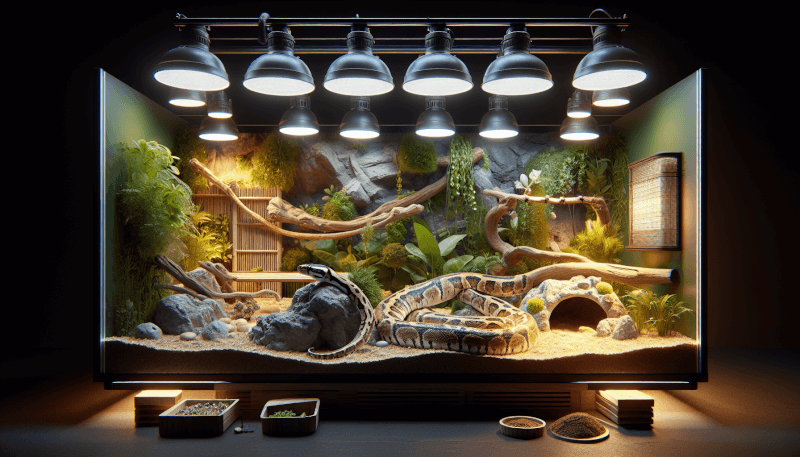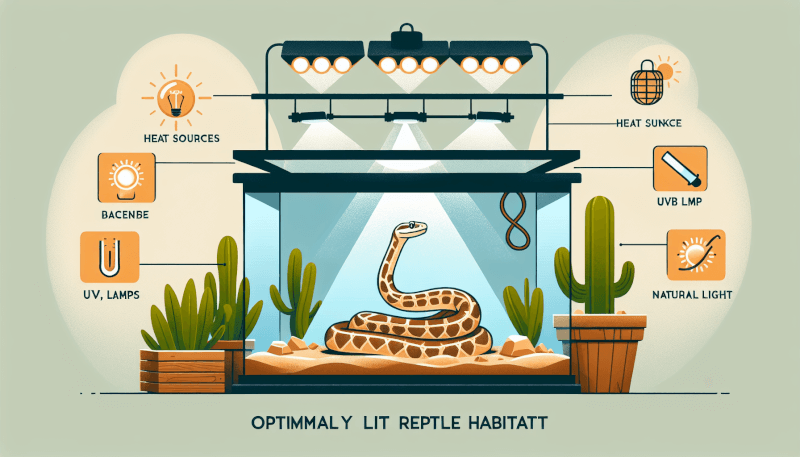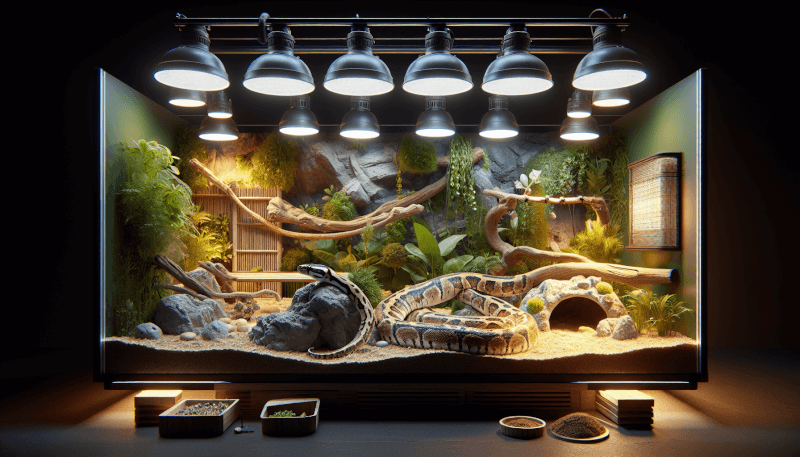It’s important to ensure that your snake’s habitat is well-lit, as lighting plays a crucial role in their overall well-being. Whether you’re a first-time snake owner or a seasoned reptile enthusiast, choosing the right lighting for your snake’s habitat can seem overwhelming. With so many options available, it’s essential to understand the specific needs of your snake species and the benefits that different types of lighting can provide. In this article, we’ll guide you through the process of selecting the perfect lighting for your snake’s habitat, so you can create a comfortable and healthy environment that allows your scaly friend to thrive.
Factors to Consider
When setting up the habitat for your snake, there are several factors to consider in order to ensure their well-being and promote a healthy environment. These factors include temperature requirements, UVB lighting, day/night cycle, and safety precautions. By carefully considering each of these aspects, you can create the ideal environment for your snake to thrive.
Temperature Requirements
Snakes are ectothermic animals, which means they rely on their environment to regulate their body temperature. It is essential to provide them with a temperature gradient within their habitat, allowing them to move between warmer and cooler areas as they need. This can be achieved by using different heating elements strategically placed in the enclosure.
Understanding Thermal Gradients
A thermal gradient refers to the range of temperatures available for your snake to choose from. By providing a basking spot with a higher temperature at one end of the enclosure and a cooler area at the other end, you allow your snake to move freely and regulate its body temperature. This mimics their natural behavior in the wild and promotes their overall well-being.
Choosing the Right Wattage
Selecting the appropriate wattage for your heat source is crucial to maintain the desired temperature gradient. The wattage will depend on the size of your enclosure and the species of snake you have. It’s important to research the specific needs of your snake and consult with a reptile expert if you are unsure.
Positioning the Heat Source
Proper positioning of the heat source is essential to ensure your snake’s safety and comfort. It is recommended to place the heating element on one side of the enclosure, creating the desired thermal gradient. This allows your snake to retreat to a cooler area if it becomes too warm and vice versa. It’s crucial to monitor the temperature regularly to ensure it remains within the appropriate range.

UVB Lighting
UVB lighting plays a crucial role in the health and well-being of snakes. While most snakes are not reliant on UVB radiation like reptiles or amphibians, exposure to a low level can still benefit them.
Why UVB Lighting is Important
UVB lighting helps in the synthesis of vitamin D3, which is essential for calcium absorption in snakes. Proper calcium levels are vital for bone health and the prevention of metabolic bone disease. While snakes can obtain some UVB radiation through natural sunlight if provided with an outdoor enclosure, it may be necessary to supplement this with artificial UVB lighting.
Selecting the Appropriate UVB Emitter
When selecting a UVB emitter, it’s essential to choose one specifically designed for reptiles. Ensure the UVB light is appropriate for the particular species of snake you have and consider the size of your enclosure. It’s crucial to follow the manufacturer’s recommendations for placement and duration of UVB exposure, as overexposure can be harmful to your snake.
Day/Night Cycle
Providing the appropriate day/night cycle is crucial for maintaining your snake’s natural behavior and promoting their overall well-being. Snakes, like many animals, have evolved to follow a regular pattern of light and dark, and it’s important to simulate this in their captive environment.
Providing the Right Photoperiod
The photoperiod refers to the length of light and dark periods within a 24-hour cycle. Research the natural behavior of your snake species and mimic the appropriate duration of light and dark periods within their enclosure. This can be achieved by using timers to control the lighting in the enclosure.
Simulating Natural Lighting
In addition to proper light duration, it’s essential to consider the quality of lighting within the enclosure. Natural daylight simulation can be achieved by using full-spectrum bulbs that replicate the spectrum of sunlight. These bulbs provide a more natural lighting environment for your snake’s habitat and can positively impact their behavior and overall well-being.

Safety
Ensuring the safety of your snake and the habitat is of utmost importance. When using any type of lighting or heat source, it’s essential to take certain precautions to prevent accidents and minimize potential hazards.
Heat Lamp Safety Precautions
If you opt for using heat lamps or any other type of bulb, it’s vital to select fixtures specifically designed for reptile use. Make sure the fixture is securely fastened to prevent it from falling into the enclosure and potentially injuring your snake.
Avoiding Fire Hazards
It’s crucial to keep flammable materials away from any heat source in the enclosure. This includes bedding, decorations, or any other materials that could catch fire. Regularly inspect the enclosure to ensure there are no frayed wires or other electrical hazards that could lead to a fire.
Incandescent Bulbs
Incandescent bulbs are a common choice for providing heat in snake enclosures. They produce heat by emitting light and can help create the desired thermal gradient.
Advantages
The main advantage of using incandescent bulbs is their affordability and availability. They are widely accessible and come in various wattages to suit different enclosure sizes and snake species. Incandescent bulbs also provide heat and some visible light, simulating a natural daylight environment.
Disadvantages
One of the drawbacks of incandescent bulbs is their higher energy consumption compared to other lighting options. They also have a shorter lifespan and need to be replaced more frequently. Additionally, incandescent bulbs do not emit UVB radiation, so if UVB exposure is necessary for your snake species, additional lighting will be required.
Choosing the Right Wattage
Choosing the appropriate wattage for your incandescent bulb depends on the size of your enclosure and the temperature requirements of your snake. It’s vital to monitor the temperature regularly with a reliable thermometer and adjust the wattage accordingly to maintain the desired thermal gradient.

Fluorescent Bulbs
Fluorescent bulbs are another popular option for snake enclosures, offering both visible light and UVB radiation.
Advantages
One of the main advantages of fluorescent bulbs is their energy efficiency. They consume less energy compared to incandescent bulbs and have a longer lifespan. Fluorescent bulbs also emit UVB radiation, which is essential for snakes requiring it. They are available in different types, each designed for specific UVB emission levels.
Disadvantages
Fluorescent bulbs tend to be more expensive compared to incandescent bulbs. They also emit less heat, which may make it challenging to maintain the desired thermal gradient, especially in larger enclosures or colder climates. It’s crucial to use additional heat sources if necessary to ensure proper temperature regulation.
Choosing the Right Type
When selecting fluorescent bulbs, it’s essential to choose ones specifically designed for reptile use. Different snake species may have varying UVB requirements, so research the specific needs of your snake and consult with an expert to ensure you select the right type of fluorescent bulb.
Ceramic Heat Emitters
Ceramic heat emitters are an excellent option for providing heat in snake enclosures without emitting light.
Advantages
Ceramic heat emitters are popular because they emit heat without light, making them ideal for nocturnal species that require darkness for proper rest. They have a longer lifespan and are energy-efficient. Ceramic heat emitters also distribute heat evenly, helping to maintain a consistent temperature throughout the enclosure.
Disadvantages
One potential disadvantage of ceramic heat emitters is the higher upfront cost compared to other heating options. As they don’t emit any light, they can’t be used as the sole light source in the enclosure. If UVB exposure is necessary for your snake, additional lighting will be required.
Selecting the Appropriate Wattage
When choosing the wattage for a ceramic heat emitter, consider the size of your enclosure and the temperature requirements of your snake. It’s essential to carefully monitor the temperature and adjust the wattage as needed to maintain the desired thermal gradient.

LED Lights
LED lights are a versatile lighting option that can provide both visible light and specific spectrums tailored to your snake’s needs.
Advantages
LED lights are energy-efficient and have a long lifespan, making them a cost-effective option in the long run. They are available in various spectrum options, allowing you to create a customized lighting environment for your snake’s habitat. LED lights also produce minimal heat, which can be beneficial in maintaining the desired thermal gradient without additional cooling measures.
Disadvantages
One potential disadvantage of LED lights is their upfront cost, as they tend to be more expensive compared to other lighting options. Additionally, if UVB exposure is necessary for your snake, LED lights alone may not provide the required UVB radiation, requiring additional UVB sources.
Selecting the Right Spectrum
When choosing LED lights, consider the specific spectrum needs of your snake. Some species may benefit from certain spectrums that mimic natural lighting conditions. Research the lighting preferences of your snake and select LED lights that provide the appropriate wavelengths to meet their requirements.
In conclusion, choosing the right lighting for your snake’s habitat is crucial for their overall health and well-being. By considering factors such as temperature requirements, UVB lighting, day/night cycle, and safety precautions, you can create an environment that closely mimics their natural habitat. Whether you opt for incandescent bulbs, fluorescent bulbs, ceramic heat emitters, or LED lights, selecting the appropriate wattage, type, and spectrum will ensure your snake has everything it needs to thrive in its enclosure. Remember to regularly monitor and adjust the lighting and temperature to meet your snake’s changing needs.


